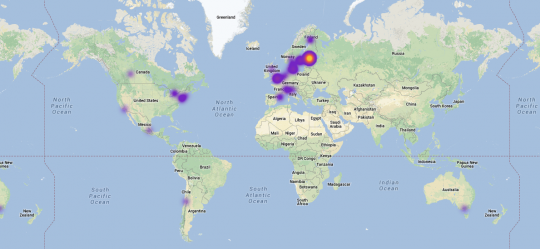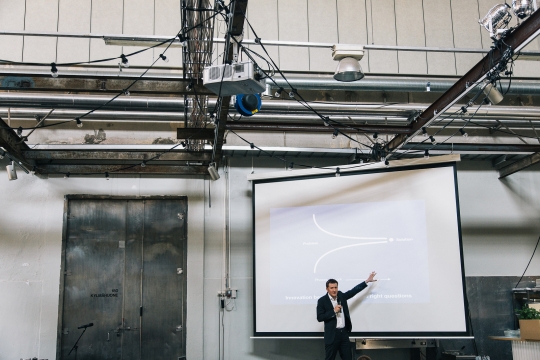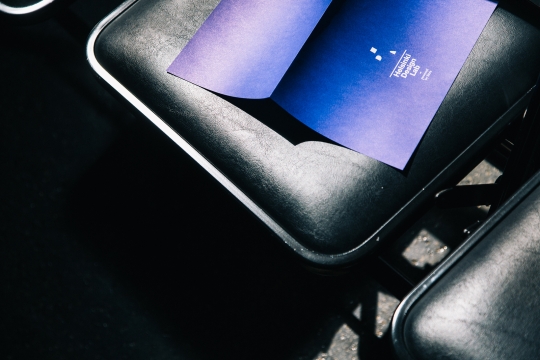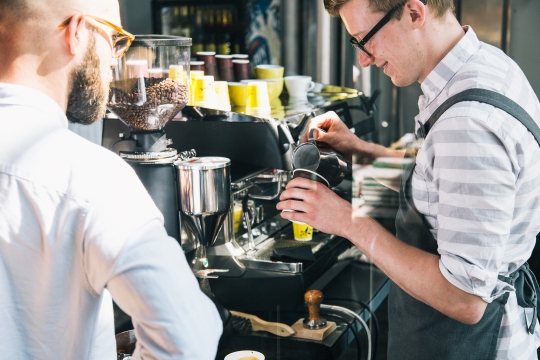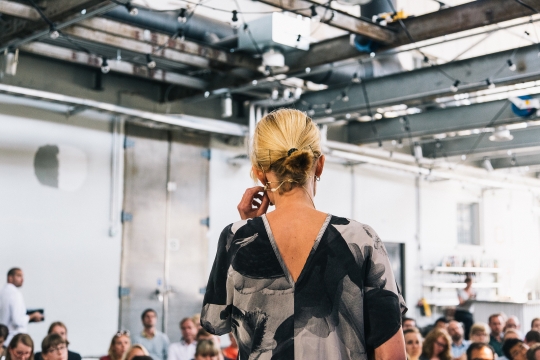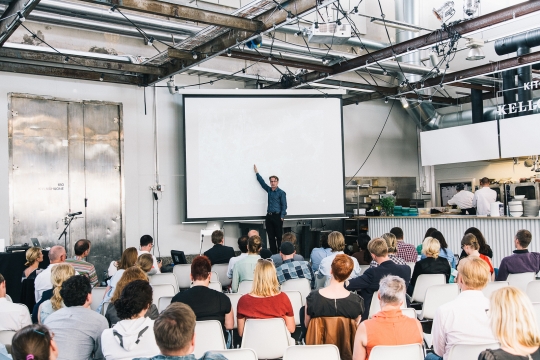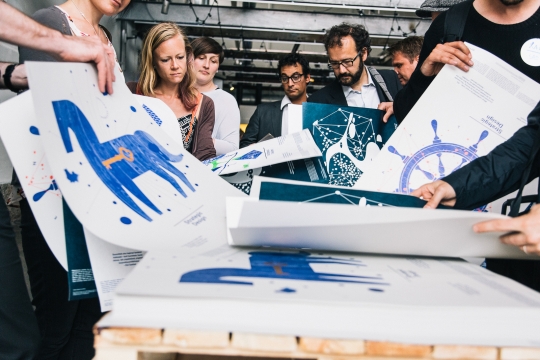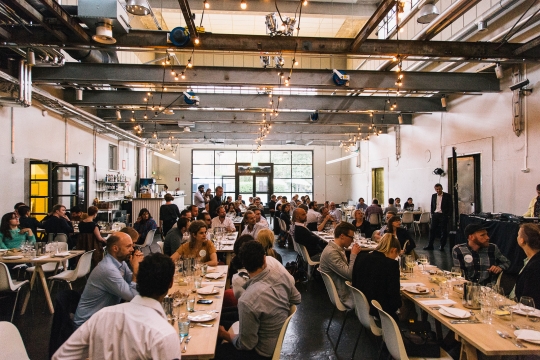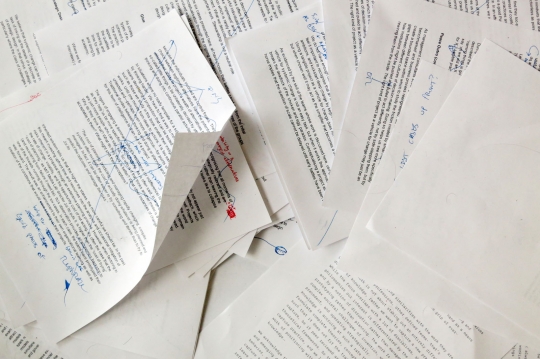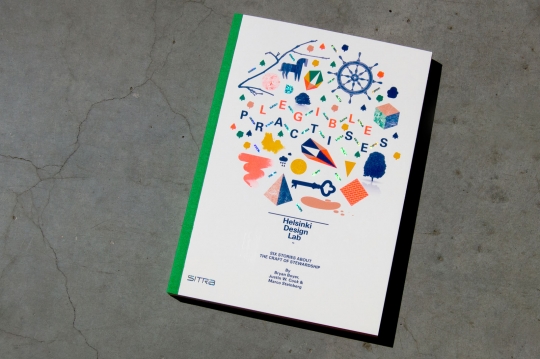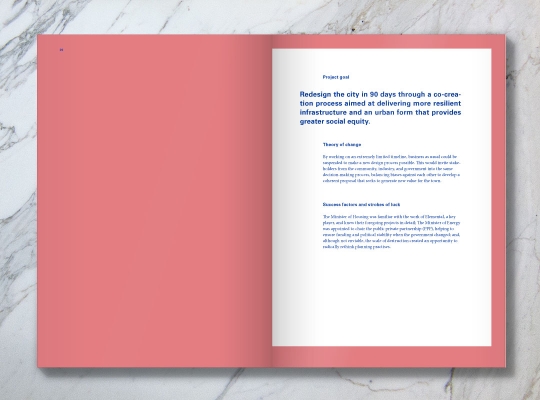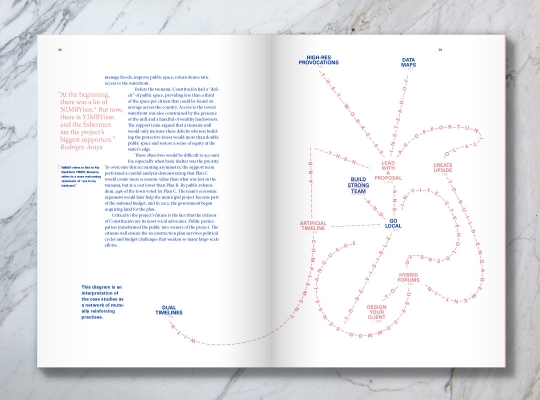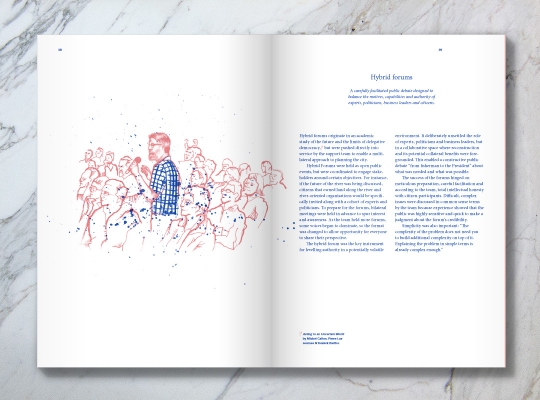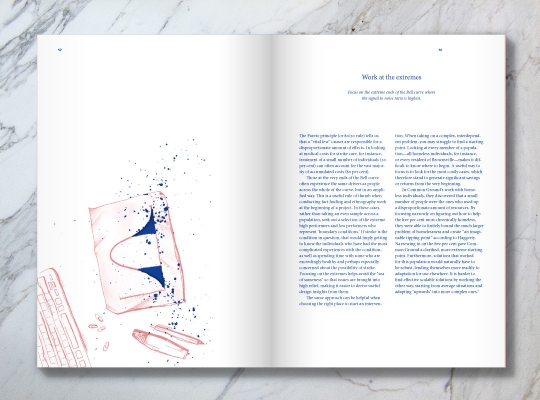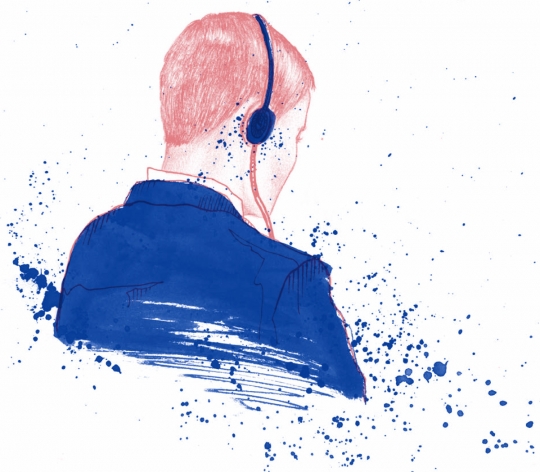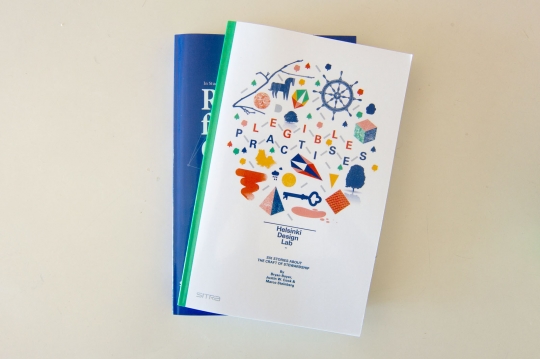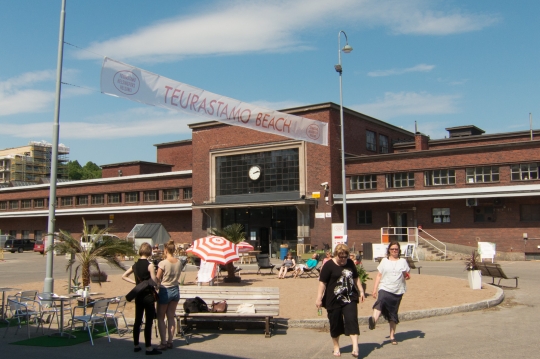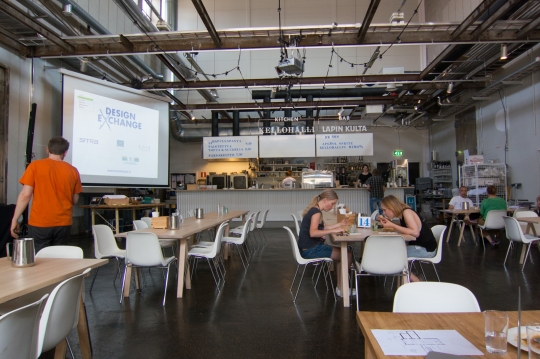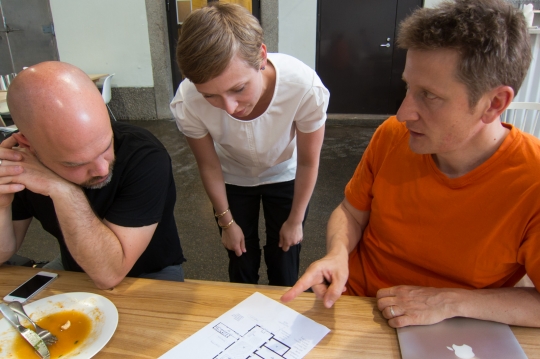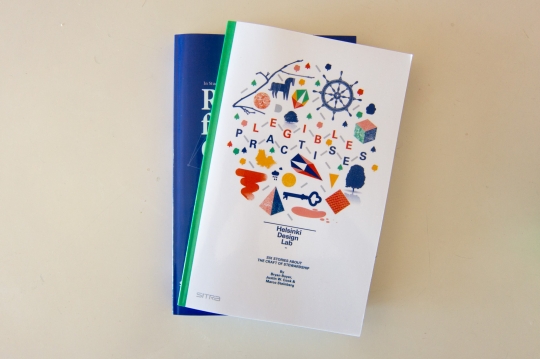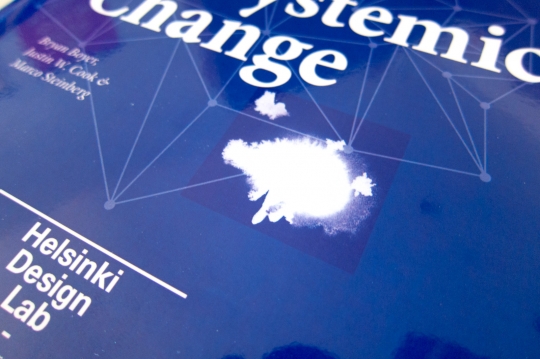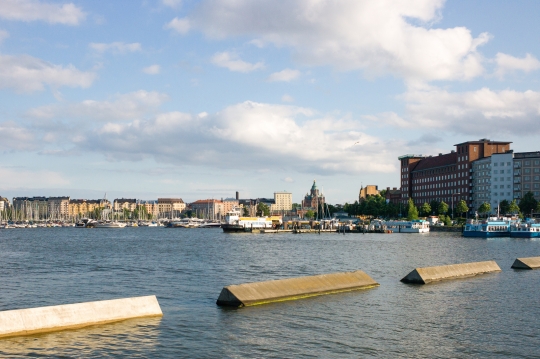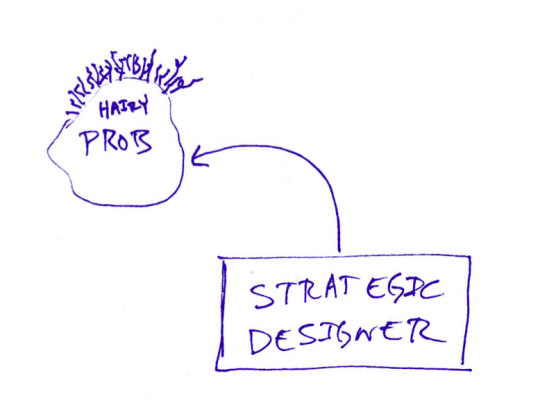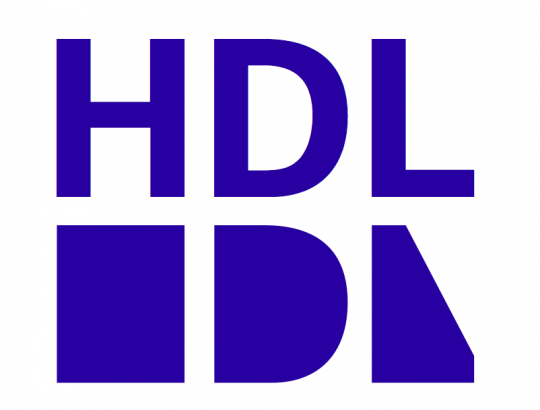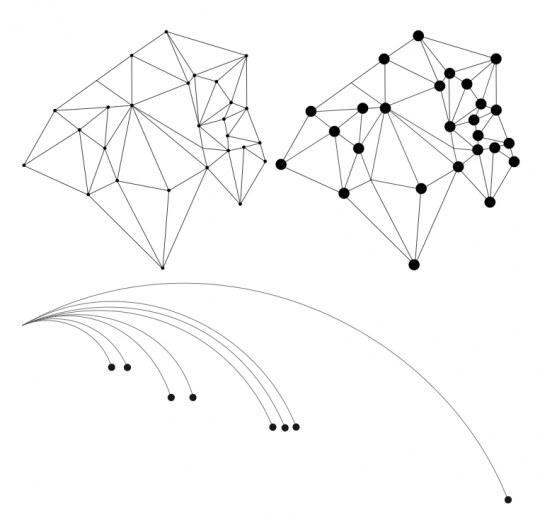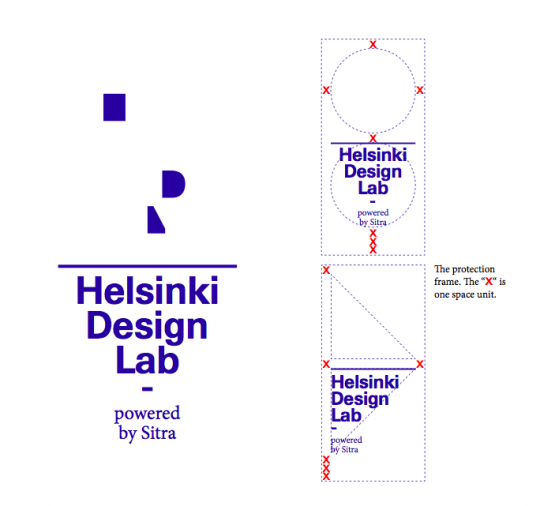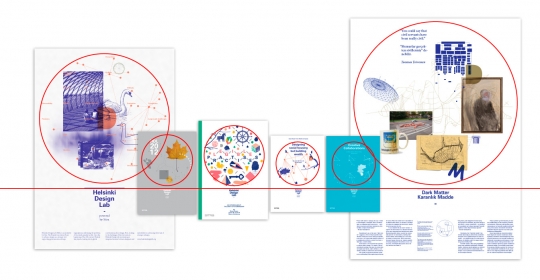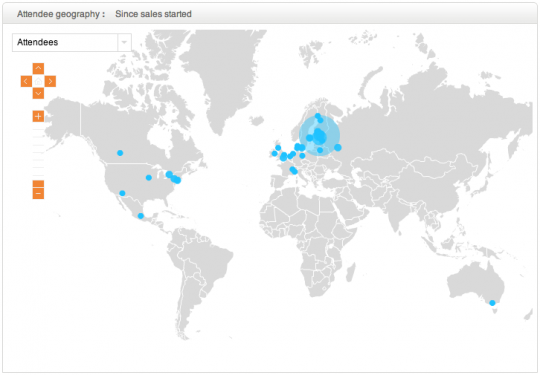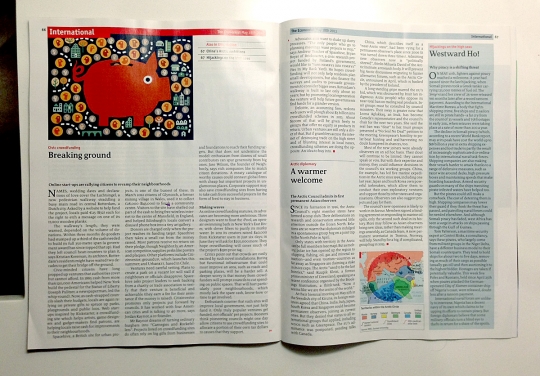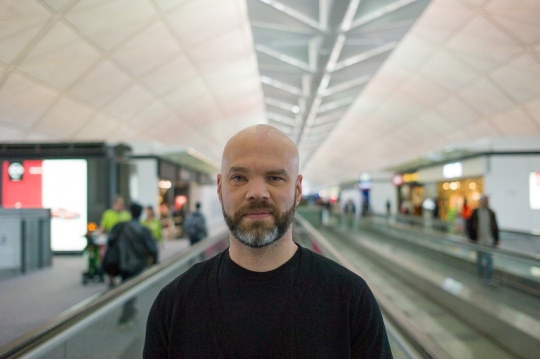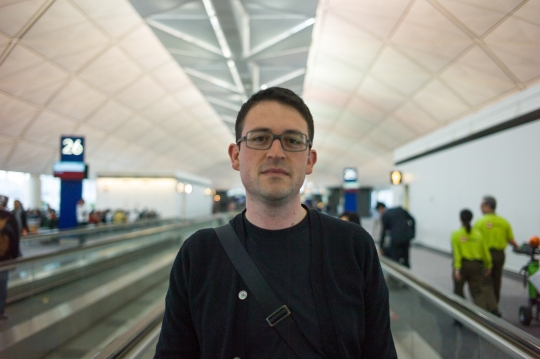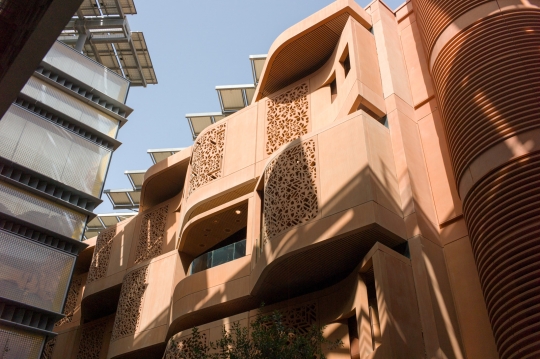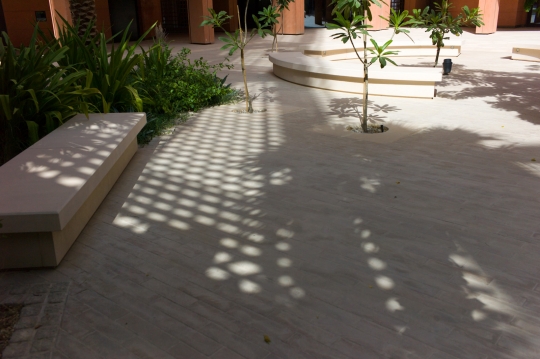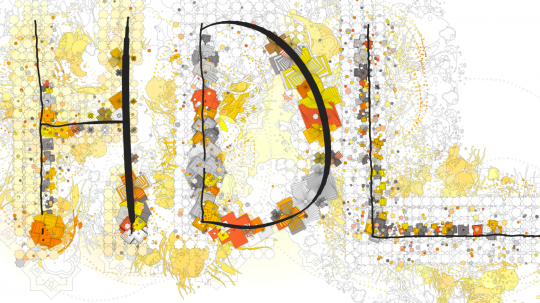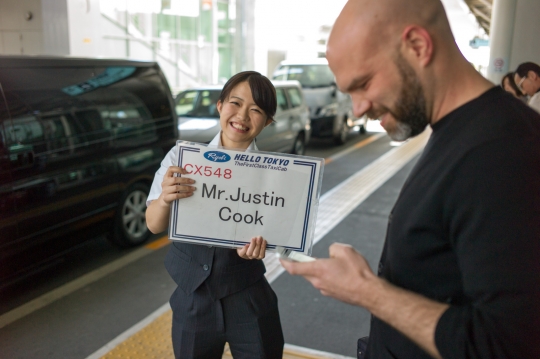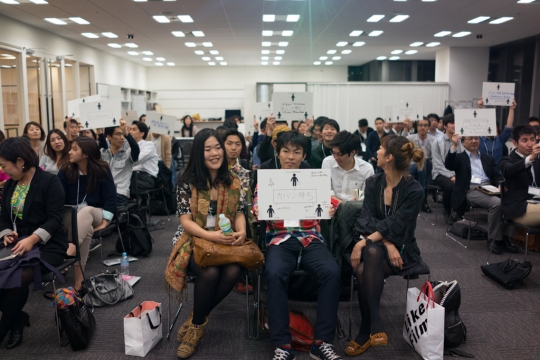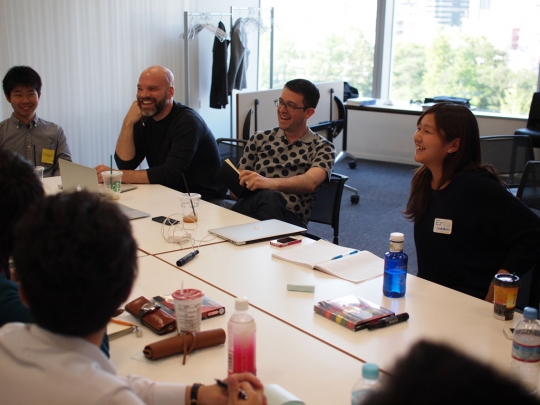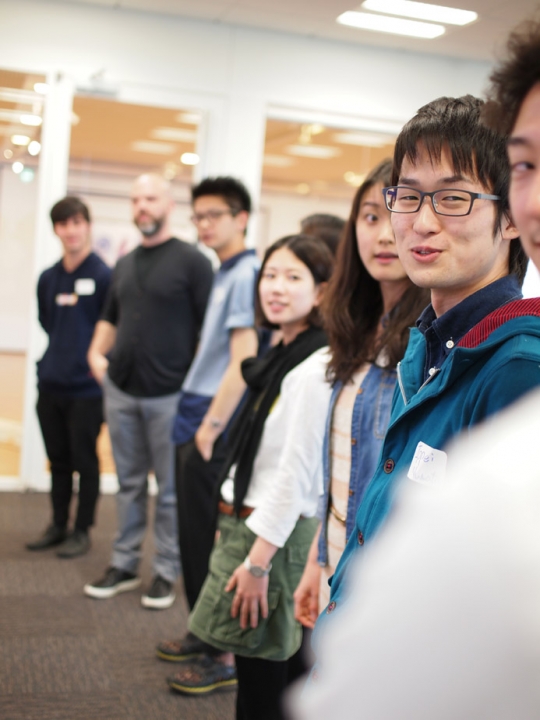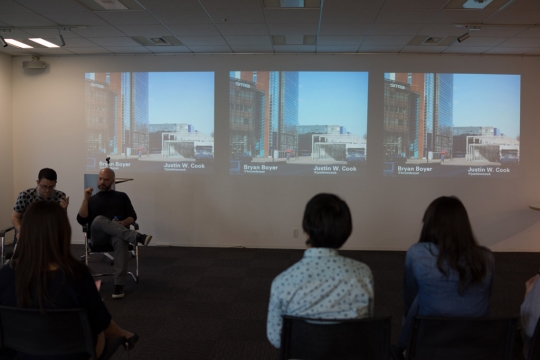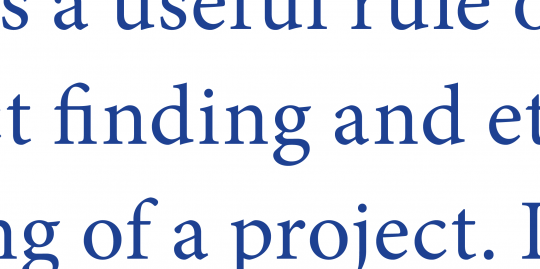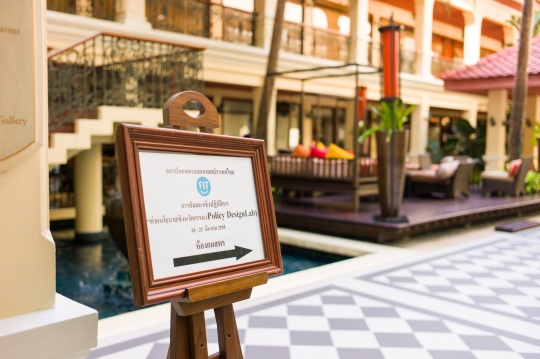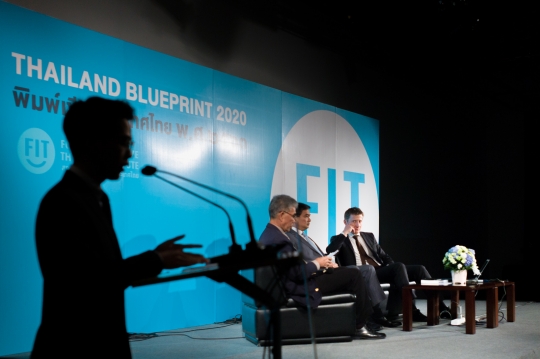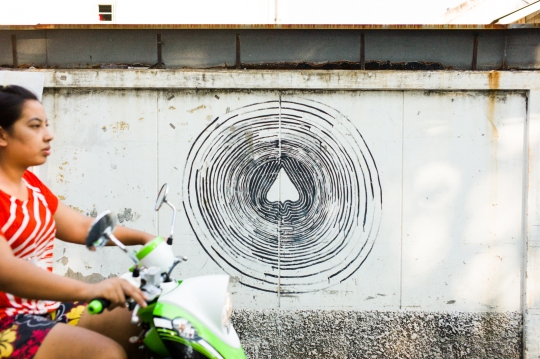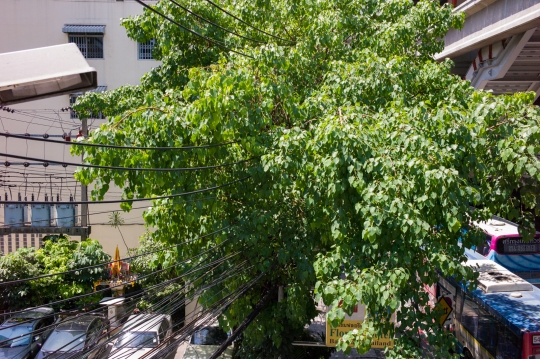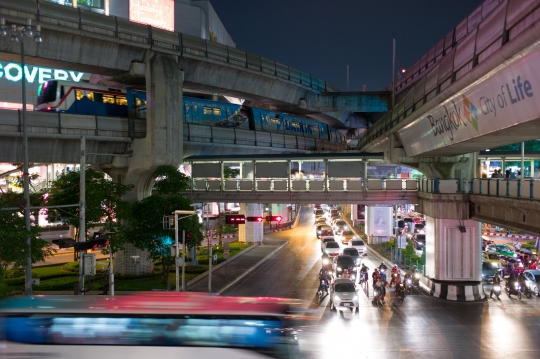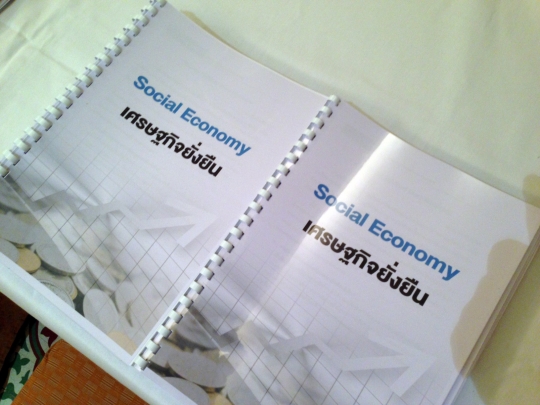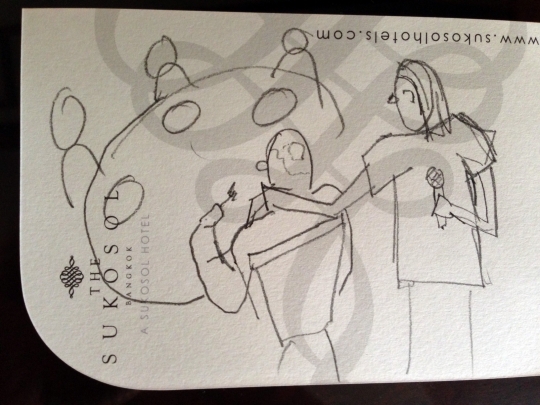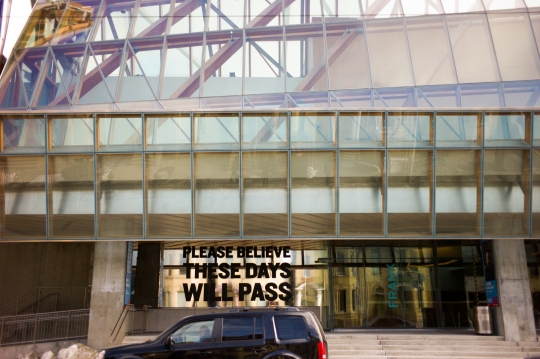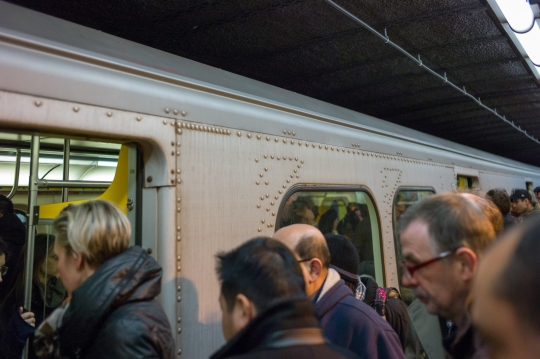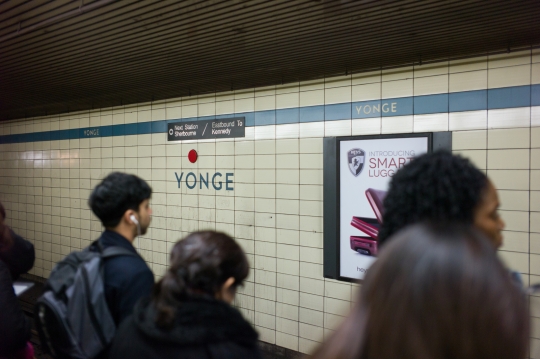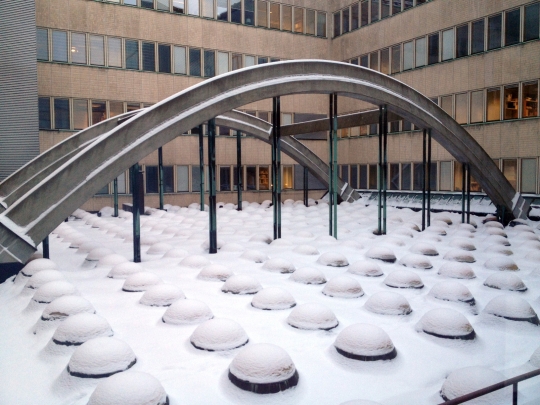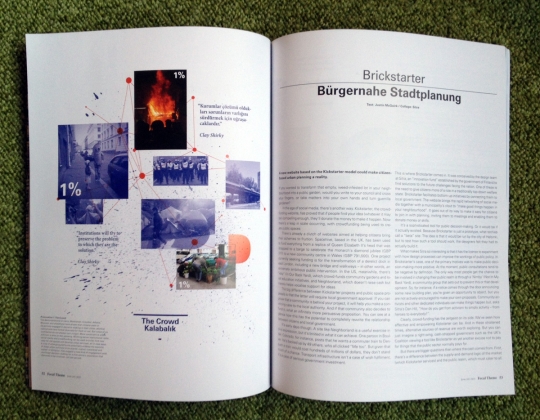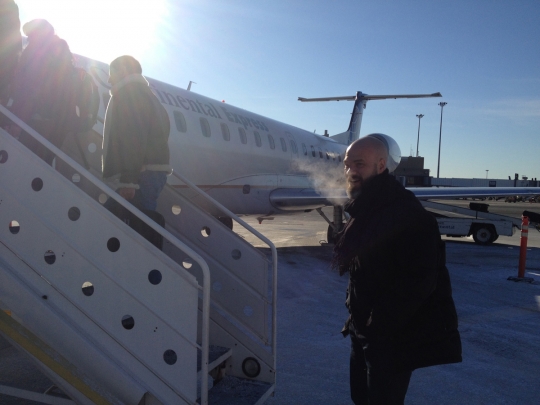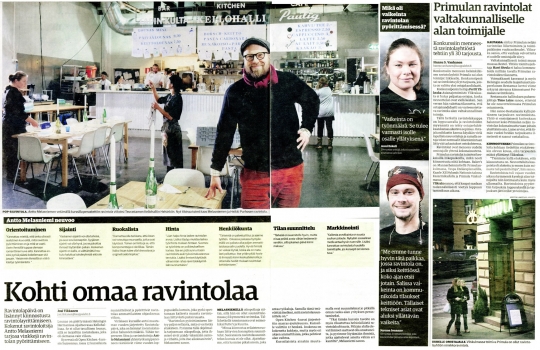All posts by Bryan Boyer
This might be the most common question we've received lately, so as we prepare to close out HDL and this blog we want to share some thoughts on the subject. Below I dip into the weeds a bit with some macro thoughts on social change but, if you can stick with it, I do actually answer the question eventually.
Organizations, like Sitra, think about the world and the impact they want to create, which is usually expressed in a mission statement. This describes the world we would like to see. On a more frequent basis we define strategies that represent our best guess about how we will most likely be able to achieve the impact we believe is important.
And while these missions and strategies may be well formulated, they do not always necessarily match up with society. Indeed, a good bit of the value of an independent organization like Sitra is that it has the mandate and resources to think about things which are not on the top of society's mind right this moment.
But this also creates a challenge: Sitra represents approximately 120 out of the 5.4 million people who live in Finland. How do the actions of 0.0022% of a country create meaningful change?

Organizations like ours often try to push society. We prepare reports and studies that compile the facts, and those facts in turn lay out a case for change. By launching programmes and initiatives we attempt to push individuals and other organizations to behave differently—to seek different outcomes.
With the HDL projects we've been testing a different approach, one that works by pulling individuals and organizations towards our vision. In a time of low signal-to-noise ratio—when there's lots of noise—being smart and having the facts is not enough. We also have to provide an offering that is so compelling, perhaps even seductive, that it can attract attention and interest of collaborators.
Push makes sense when you know exactly what the market wants (be it a literal market or a 'market of ideas'). Pull makes sense in a more dynamic context, or when cash and/or authority are limited.
When we think about social change through the lens of push and pull, I offer the anti-smoking campaigns of 20th century as an example of push. Reducing the prevalence of smoking in society was a massive effort that was not aligned with the popular culture and media of the time, it also ran counter to the interests of some large corporations. There was significant inertia that resisted a specific and desired change: namely lowered tobacco usage rates. Affecting this change required prolonged effort on behalf of countless organizations. The movement had to be created more or less from scratch. Societies across the western world and beyond were literally pushed towards a different baseline behavior: from smoking as an acceptable norm to a default of non-smoking in many places.
To understand social change through pull, Facebook offers a good example. The world's largest social network is used by over one billion people and as much as the platform itself is a piece of technology, that technology has begun to change the world around it. Facebook affects how people convene for events, celebrate birthdays, spread gossip, and, according to the NSA in the US, how terrorism operates. All of this has happened relatively quickly and with very little money spent on attracting attention through traditional means such as marketing—Facebook did not grow through a push strategy. Instead Facebook offered something that was so attractive it pulled people in.
Without trying to valorize a particular company, what we've taken from this observation is a recognition of the competitive landscape that good ideas have to survive today. Good ideas are not enough anymore. Rarely does any one group have enough money to push ideas into the world anymore; rarely does any one group have the requisite authority to create meaningful social change by fiat.
HDL does not have the means to affect change on its own. Sitra does not have the means to affect change alone. The whole of Finland does not have the means when we think about the large scale issues such as climate! Therefore our projects have been an experiment in pulling participants, collaborators, and onlookers into projects. We pursued a pull strategy because it gave us a plausible way to leverage deeper flows of change within Finnish society.
Back to the original question: how did HDL select its projects?
The answer is that we looked for opportunities that lay between the vision that Sitra has for Finland's future and the interests of Finnish society right now. Within that opportunistic space the real challenge is not identifying a potential area or subject to work on, but to find the vehicle of change that has a high possibility of success.
A concrete example is Low2No. Sitra's interest in sustainable well-being means that we will need to address many (if not most) aspects of our economy and how we live together on a finite planet. Citymaking, the focus of Low2No, is as good of a place to start as any! We had indications that a project focusing on sustainable city making was well-timed to pull interest from the communities of development, real estate, construction, and design in Finland. When we began Low2No we were also considering a relocation of the Sitra office, so this also gave us the opportunity to address multiple needs at the same time, and for our organization to have some skin in the game.
Open Kitchen provides another example. Although Open Kitchen is ostensibly about food in Helsinki, our motivations were in addressing the sustainability of consumer choices in Finland (starting with diet), strengthening everyday entrepreneurism, and in creating proactive opportunities for new generations of immigrants to knit themselves—and be knitted—into Finnish society. Those same goals could have been addressed with a project that focused on groceries instead of street food, or even a focus-area that has nothing to do food, such as small retail shops. The reason we chose food is because there was already an existing groundswell of interest in food thanks to the successful Ravintolapäivä festival.
The project was Open Kitchen because food was a hot topic in Finnish society and our agnosticism about the content allowed us to connect our strategic goals to a variety of potential vehicles. If cycling were the thing, or meanwhile usage of spaces, or pop-up shops, or childcare, or energy, or anything else were the hot topic we would have developed Open Cycling, Open Spaces, Open Shops, etc. instead, leveraging the interest of the community. These stand a better chance to pull in the attention of finnish society, saving us from the need to create attention and interest in our subject, before we can even begin to generate interest in our project, before we can even hope to have a successful project.
How did HDL select its projects? By looking for opportunities where we could inflect existing energy within Finnish society towards the strategic priorities of Sitra and our assessment of what will be critical for Finland's vitality in the future. The financiers aren't the only ones who can enjoy the benefits of leverage.
For more on choosing vehicles for change, see the introduction chapter to Legible Practises. Readers may also enjoy a brief discussion of using projects and publications as probes to help discover opportunity.
While booting up HDL we took some time to build out the infrastructure for our future work. A central part was this website, helsinkidesignlab.org. We've already shared some of the statistics, so this post details how the website came to be and what we were thinking about when we created it.
Have a clear goal
Our goal with the site was to be "a place for designers to come together to learn more about strategic design and participate in the conversation. The HDL site also needs to serve as a resource to government officials, providing information on what strategic design is and how it can help solve their problems."
Make the goal dead simple
We wanted to be the best, clearest, and most dependable resource for information at the intersection of design and government. The primary content we would share is the story of our own evolving work. Secondarily we would highlight the work of others through cases and blog posts.
Get help
Through various engagements over the span of a few months we worked with BERG London to define the strategy for HDL's website; Brain Traffic to edit and hone the message, tone and voice of our core documents (more on this below); TwoPoints to establish a visual language; and XOXCO and Rumors to manifest all of this as the website you're now reading.
The website was my project and prior to HDL I'd spent years working in pretty much every role involved in creating a website, from programming to journalism. So I felt prepared to handle the project, and I also felt strongly that it was important to get help and make sure that the site was done right.

An example from Rumor's work on the information architecture of the site. They started by thinking through the structure of the site before anything was ever designed.
Be conscious of your audience
In a dream world we wanted to be relevant to everyone. Who wouldn't love strategic design?! We prioritized our audiences up front: other designers would be the first, followed closely by civil servants and politicians, and we wanted our materials to be accessible to interested laypeople.
This is the work of content strategy. Get someone smart like Brain Traffic to help you with it. Here's a snippet from their recommendations:
Tone and voice
Because the subject matter is a bit complex and conceptual, clearly clarifying who you are and what you do is important. Your site needs to sound academic, authoritative, and forward-thinking, yet still accessible and personal. Also, because your site operates similar to a non-profit, it should not sound commercial, because you are not selling a specific product or service.
Core messages
These are some core messages your site should convey:
1. Through strategic design, we offer new ways to solve large-scale, global problems.
2. We bring government and design together.
3. We want to advance the strategic design community.
4. We define problems and help deliver more complete solutions.
5. We take the principles of traditional design and apply them in new ways to "big picture" challenges.
Be realistic about the size of the audience
We anticipated that our audience would be relatively small. The percentage of the web audience that is interested in design is small, and strategic design much much smaller. But that's OK: While we have a small audience, they're generally quite committed—and thirsty for camaraderie and content. Building a website for an audience in the thousands is different from working on a website for the hundreds of thousands or millions. For instance, we opted not to invest in building some kind of social network (despite the desire for connectivity) and instead put our focus on publishing content.
A slow website is a nonexistent website
The web is a firehose of content. Lots of it is bad. While it would be nice to imagine that the good stuff will shine through, there's also a basic battle for attention. If you don't post, you don't exist.
We made a commitment early on to post regularly (in the form of weeknotes). This forced us into the habit of regularly documenting what we're doing, and also ensured that there was a steady stream of content on the site. This way the site would not feel abandoned or stale.
Banners? We don't need no stinking Banners!
As a non-commercial site we're able to free ourselves from the clutter that is imposed on most commercial sites by virtue of their banner ads. Helsinkidesignlab.org has a lot of white space on purpose: we want our readers to have a sense of clarity and focus when visiting the site. We don't need banners, so why have them?
Painless posting
Regular posts would not be easy to imagine without a painless interface for posting new content. Although off-the-shelf systems such as Wordpress are cheap, they can also be ill-fitted to specific situations and clumsy to use. We opted to build our own custom content management system using XOXCO's PeoplePods platform.
Now that the blog is closed (or nearly so) we can reflect a bit on what it was. I asked Ben of XOXCO to take a look at the database and find what details he could dig up. Here's what he found:
Number of posts: 241
Total words published: 128,204
Average words per post: 532
First post on: January 31, 2009
Total number of days the blog was live: 1259
Averaging one post every: 5.2 days
Longest post: Guest Blog: The Takeaway is People (2718 words)
Total comments: 58
Average comments per post: 0.24
If the blog were a printed book, it would come out to about 500 pages of pure text, not including any images or other supporting materials.
One revelation from doing this number crunching is the shockingly low number of comments! Although people did not have much desire to engage, they did read. The readership grew nicely over time to level out around 5000 visitors per month:

January 2009—September 2011 (the dive at the end is due to switching from the old website to this new one)
And over that span of time we saw healthy traffic from six continents, with clear clusters around Helsinki, London, the east coast of the US, and southern Australia.

Geographic location of visitors, courtesy of Google Analytics
As we're putting the finishing touches on the HDL living archive (what this site will shortly become) here are some images from our closing event, HDL Global 2013.
We were joined by 116 people from five continents. With talks from a mix of newscomers and old friends alike, it was an excellent way to pass the torch—to you!
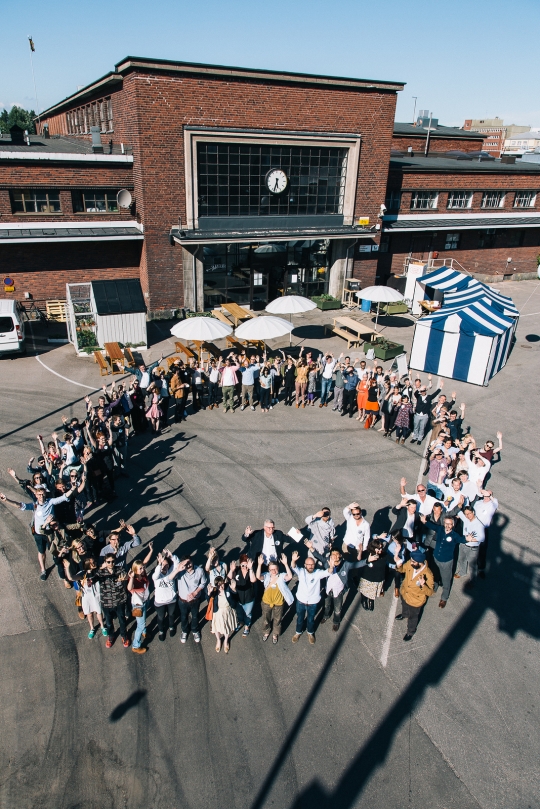
This and other images below by Johannes Romppanen
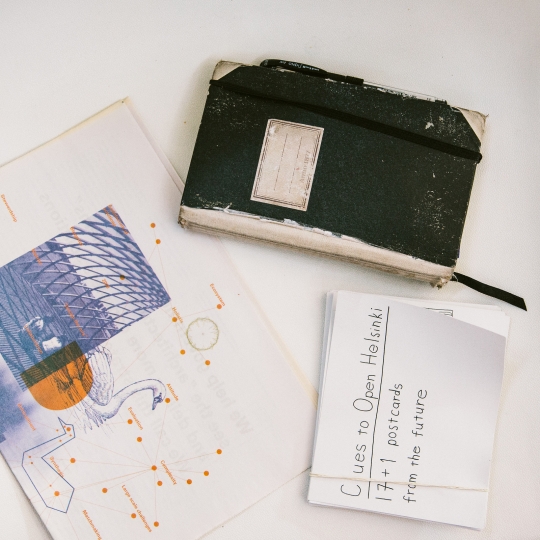
One in a series of chair portraits taken by Johannes.
There are many more photos on our Flickr page.
HDL Speaker Timo Arnall also has a collection of great photos from the event.
On Monday we launched our latest (and last) book, Legible Practises. This post shares the thinking behind the book, but if you just want to get your hands on it you can download the full PDF or order a copy via print on demand.
We wrote Legible Practises because we hope to bring attention to the craft of involved in stewarding institutions towards new new behaviors, new roles, and new purpose. This stems from a hunch that built slowly over five years, which is best explained in the preface:
...We have been lucky to participate in a global conversation with communities spanning from design to public service, technology to activism. Although each has its own set of tools and approaches, what struck us was the degree to which similar themes emerged again and again. The words may have been different, but the nature of the challenges and the styles of response were often remarkably comparable. Yet each spoke as though they were working in relative isolation.
Perhaps this should be no surprise, given the challenge of a world where many things seems to be changing, including the ways we live, eat, communicate, and just about everything else. As our needs span the silos of today’s society, the boundaries of our disciplines and the relationships between them will inevitably also have to adjust. Some are already doing this proactively; they know that it can be lonely on the edge.
To be an effective practitioner during a moment of flux is to be concerned with the discipline of one’s work as part and parcel to achieving better outcomes. The most accomplished practitioners do this naturally, but are often too busy to stand back and reflect publicly on a meta-level, let alone take the time to package and publish their approaches legibly. Sharing tends to focus on the endgame, without much elaboration of how it was played. When we read about promising social innovations in faraway places, we get half the story: sanitised of missteps, triumphant over adversity, effortless.
But hop on a plane and spend a day with one of these practitioners and a different story is revealed, a richer and more informative one. Last summer we had the luxury of doing just that. We listened closely to project teams as they explained their work in detail. We hosted three sessions, each bringing together two cases for a simultaneous discussion, concluding with full notebooks, large audio files, and our heads happily aching.
With this book we have zoomed into the promising practises of six groups to highlight shared tools and approaches, as made legible by concrete examples. In many ways this was a selfish act, one motivated by our own inquisitiveness and interest in learning from the best. More importantly, however, we hope to spark a conversation about the deep craft of social innovation as a reminder that, even when dreaming big, the details still matter.
Nesta, MindLab, IDEO, Community Solutions, Tironi & Elemental, and Government Digital Services were gracious enough to allow us to study their work. They provided the big dreams. We hosted a series of discussions, each bringing together a pair of cases, and then set to work distilling the outcomes into this text. Our work was to make the bridge between the dreams and the details explicit. We did this because we think that it might help others (including ourselves) learn quicker.
Each case is presented with a basic overview, a narrative that's a few pages long, a 'network of practise' diagram, and a series of points of practise that are illustrated by the case in question but by no means exclusive to it. In the one page overview we itemize the goal, theory of change (in our words), and strokes of luck. This last item is particularly important: if there were aspects of the project that would be impossible or extremely difficult to replicate, we've attempted to notify the reader of that upfront so that they can immediately start looking for alternatives.
The narrative does what narratives do: it gives you the overall arc of the story, describes the starting point and the status of the project (at time of writing), and introduces the main characters.
The 'network of practise' is a diagram we've invented to show a web of relationships between the points of practice in the book. This comes out of a taxonometric problem that we encountered when compiling the list of points of practice. On the one hand, it felt like we should divide them into a taxonomy with categories such as tools (data map, project blog, audio interview), methods (create upside, public beta), qualities (work at the extremes, create upside)… but this felt premature given that we've only studied six cases. We could certainly create a taxonomy, but that already implies a formality of knowledge that we were not comfortable with. One of the starting points of the study was the fact that different disciplines were all aiming at the same problem, which indicates that this moment is one of flux more than fixity. Using this network rather than a taxonomy avoids the problems of moving from one set of silos to another, and instead puts the emphasis on the individual points and how they connect.
As an open-ended system, the network diagrams show linkages between items and help the reader come to their own conclusions about the relationships between them in terms of scale, importance, and directionality. The diagrams include a mix of the points in the case in question, other cases in the book, as well as some points which are not covered at all in the book. Again, open-ended. Still in development. Evolving.
We've put our emphasis on decomposing the stories into building blocks: it's up to you to recombine them in whatever way is useful. Twopoints interpreted the networks so that each takes on its own visual form, its own identity. This leads to a good question: might we find a way to draw different kinds of institutional changes as typologies that have similar forms? Could we draw similar challenges in a way that helps an emerging community of practise develop a shared language for 'spiky problems', 'flat problems', 'round problems', etc? We have not engaged with that possibility here, for want to a large enough body of cases to do the idea justice, but perhaps at a future date.

The cases take on their own identity through shape.
Next come the points of practise, which are a mix of tactics, tools, qualities, and probably some other broad categories we've neglected to see. Each point of practice is told through the case it's attached to, but is relevant to other cases as well (as exhibited in the network diagrams).
A subset of the points of practise are illustrated with drawings by Lucia Walter. This decision came out of a desire to add some visual content to the text. Choosing between photos and illustrations was rather simple: people rarely take photos of their process (unless they're like obsessive like the author of this post). But resorting to illustration was also important because it gave us a chance to bring the texture of handcraft into the book. We selected Lucia because her work in pen and ink is obviously rendered as a playful mix of purpose and happy accident. The style of the illustration is an embodiment of the notion of stewardship that we explore in the text itself.
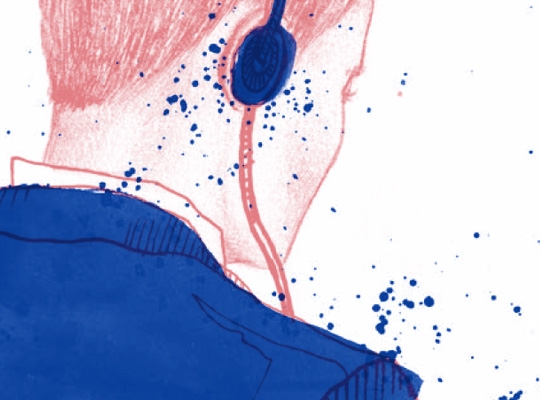
Evident handwork
Legible Practises is not attempting to be a definitive. Rather, we've hoped to nudge the discourse(s) on institutional change, on social innovation, on strategic design in a direction that engages the material practices as seriously as it does the cognitive ones. Like all of our publications, we've taken the liberty to experiment with the formatting and the execution without letting that diminish the thinking. Whether any of these experiments have worked it up to you to decide. We hope you like it.
In parallel with publishing Legible Practises as a hardcopy book on beautiful paper, with two color inks, and a swiss binding, we've also made it available via print on demand using Lulu.com. We have experimented with Lulu in the past and while it's not as nice as bespoke printing, their global distribution is important. By making the book interiors black and white we've also been able to offer it for a very low price.

Black and white interiors mean that the books are cheap. In Studio is $13 USD and Legible Practises only $7.
And while we were at it, we also made In Studio: Recipes for Systemic Change available via print on demand.
T-Minus 3 days till HDL 2013.
That means we're on site at the venue doing AV checks, finalizing meals, printing programmes, and the like. Today we moved boxes upon boxes of HDL books, posters, and other material to Kellohalli. We'll be giving them all away to attendees.
Apart from that, we're working on a revision to the website that will serve as the final update. There won't be any major changes, but we're taking the opportunity to adjust things like the navigation and organization of the site so that it's as useful an archive as possible for people who happen upon it.
Because Everything Is Connected, redoing the website means also revisiting some of the publications. We've created print-on-demand versions of In Studio and Legible Practises, both of which will be cheap and available globally.
OK, back to event preparations.
In case you missed it, earlier this week we shared the story of the HDL visual language,how we brief photographers, and a few of our favorite spots around town (for those coming to the event and finding themselves with a bit of free time). That makes this a four-post week.
We have about 200 people joining us for HDL 2013 next Monday and a good portion of them are coming from outside Finland. In case you're not familiar with the city, here are some suggestions for things to do when you're not at the event.
Meals
nb. Restaurants in Helsinki can have idiosyncratic hours and often book up quickly. It's best to check online before you visit, or even give them a ring.
Atelje Finne
14 Arkadiankatu
Modern Finnish cuisine in what used to be a sculptor's studio.
Kolme Kruunua
Liisankatu 5
A little slice of Finland circa 1950. Try the meatballs or the salmon soup.
Dong Bei Hu
Korkeavuorenkatu 47
It sounds odd to have Chinese food in Finland, but this is some of the best to be found outside of the Middle Kingdom.
Glass of wine
Latva
Korkeavuorenkatu 25
Occupying a quiet corner in one of Helsinki's leafier neighborhoods.
Open late
Putte's
Kalevankatu 6
Pizza and drinks with grad students and cool kids.
Coffee or a small breakfast
SIS Deli
Kalevankatu 4
Coffee, tea, and snacks in a crisp space.
Fratello Torrefazione
Yliopistonkatu 6 (inside the Kluuvi mall)
Good coffee & good people-watching on a busy downtown street.
Good Life
Kolmas Linja 17
Part of Finland's new wave of coffeeshops.
See a bit of Helsinki
Kulttuurisauna
Hakaniemenranta 17
Relax in Helsinki's newest (and best) wood-fired public sauna. Like none other.
Ateneum
Kaivokatu 2
Go for the paintings by Finnish masters Akseli Gallen-Kallela and Hugo Simberg.
Suomenlinna
Pohjoisesplanadi 39
Have a walk around this island fort just off the cost. Public transport takes you there and back from Kauppatori, the market square.
Bring home something nice
Design Forum
Erottajankatu 7
Selling a wide variety of products by local designers.
Artek
Eteläesplanadi 18
More than sofas, but those are nice too.
Iittala
Pohjoisesplanadi 25
Glassware and other things for the home since 1881.
In the design world there's an obsession with "representation," or the act of representing ideas and concepts in media (be it a poster, a book, or a building). In part this obsession stems from the recognition that an idea in your head is only as useful or as interesting as your ability to articulate it in a way that can be shared with others (in whatever medium suits you and them). How you present your thinking matters. But the term designers use is is "represent", not "present." The former shyly evokes two important relationships: one in time and one scalar.
To "re-present" an idea is to perform its meaning anew. Expressing something in new ways, perhaps unexpected ways, has the potential to help us refine the very thought that we were trying to express in the first place. This is the essence of "talking through" a notion: making successive attempts to explain something helps clarify the thing itself. Representing ideas is not frivolous, it's essential. Representation helps us understand the essence of what we are trying to share.
But "representation" is also important in the realm of political science, where it implies that an elected official represents the interests of their constituents. This is a scalar relationship where one vote effectively represents many, even if the many might each have their own variations if asked directly. Implicit in this one to many relationship is a basic fungibility: because it's impossible for one vote to capture all of the nuance of the many that it stands in for, there's always the possibility that the 'one' can change. The same can be said for any act of visual expression: when a book goes to press, for instance, the cover that is chosen is not some inherently perfect crystallization of the ideas, but it's the right expression at the moment a decision was made, for the people who made it. The selected expression sits at one terminus of a family tree of options (and families of options).
In the spirit of being concerned with representation in both senses of the word I thought it would be interesting to show some of the background thinking that went into the HDL brand itself. Before beginning work on the first HDL website, which would become the public face of our initiative, we invested some time (and a little money) into clarifying our visual language. To help us with this work we hired TwoPoints.net, a Barcelona-based graphic design firm who we've now had the pleasure of working with on multiple occasions over the past four or so years.
When I met with them in their small studio we started from zero. What is strategic design? Having arrived on an overnight flight from California, I was speaking in the weird metaphors that proper jetlag inspires. They giggled when I described strategic design as being concerned with "hairy problems". Even still, Martin and Lupi try to sneak this into our collaborations.
But no, it's not as literal as a hairy McNugget (though that would be problematic). By hairy I meant to imply that the sorts of issues we're concerned with are unclear, they're ambiguous, fuzzy, in motion, and often just hard to grapple with. In short, they're difficult.
The second starting point was the legacy of HDL itself. We had just recently discovereda wealth of photographs and other documents hiding in the archives. In 1968 the first HDL-related event was stylish, but because of its era it was also very paired back, appearing almost minimal to today's eyes. We wanted to evoke this and connect with the lineage of our thinking.
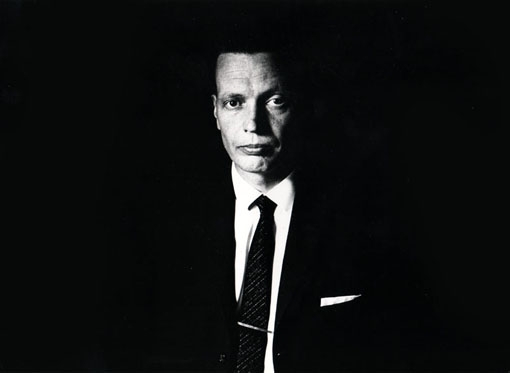

Photos: Kristian Runeberg
Third is the nature of Sitra itself. As an organization that reports to Parliament, Sitra is a serious institution, and our design-related work is no exception. We asked TwoPoints to respect the seriousness of work we were setting out to do by giving it a downplayed visual expression. The result, as you will see, if a visual language that can be rather austere in its most basic applications. We've carefully avoided graphic frills over the years. We've embraced the blank space, the negative space.
After our first meeting Lupi and Martin spent a couple weeks digesting the contents along with Irene Hwang of Constructing Communication, who was also contributing to the project. We asked them to provide us with a style guide that defined a visual language for HDL, including all of the basic such as typography, colors, and a family of layout concepts (expressed as common grids that we use in all documents).
When they finally came back to us, their document, a styleguide for HDL, opened with this:
The driving idea of the visual identity is drawn from the “space” occupied by the strategic framework of HDL, which draws together a diverse group of actors and entities from various fields. These actors, each one a specialist in his field, contributes a unique point of view within a group that can offer a more holistic definition of the problem, thereby creating the opportunity for a more effective range of solutions.
Here you can see the genome of our Studio Model already emerging. The general notion of a collaborative, multidisciplinary, design-led framework is certainly at the core of the Studio, but it's also true of our work in general. So how to express this visually?
In terms of visual representation, this space is filled by heterogeneous visual styles that serve to represent the actors with different backgrounds functioning in a holistic way.
The conceptual framework of this particular visual identity, in contrast to a “normal” branding, avoids homogeneity or uniformity in favor of highly diverse visual styles occupying the same space. Yet, given this embrace of heterogeneity, the visual identity maintains a sense of stability in order that the identity expresses trust, confidence and recognizability.
Thus, the visual identity is both flexible and constant. The identity contains two zones: 1) A flexible image space that may house corporate elements or images that illustrate a specific content and 2) The wordmark space. On the following pages we will outline the different applications of the word- and imagemark.
Facing the challenge of representing HDL as an entity that would constantly evolve as we collaborated with different actors and entities, TwoPoints chose to eschew a static logo and instead designed a visual system that is flexible, yet in all of its iterations remains recognizable.
The system is comprised of five key elements:
1. HDL elements. Shapes abstracted from the letter forms of 'HDL'. We always use at least one.
2. Colors. We are relentless in using HDL blue (Pantone 072 or RGB(0,0,120) for the curious) if you haven't noticed, and that's thanks an initial decision up front that we would use 'blueprint blue' in all of our work. The other colors are used for accent.
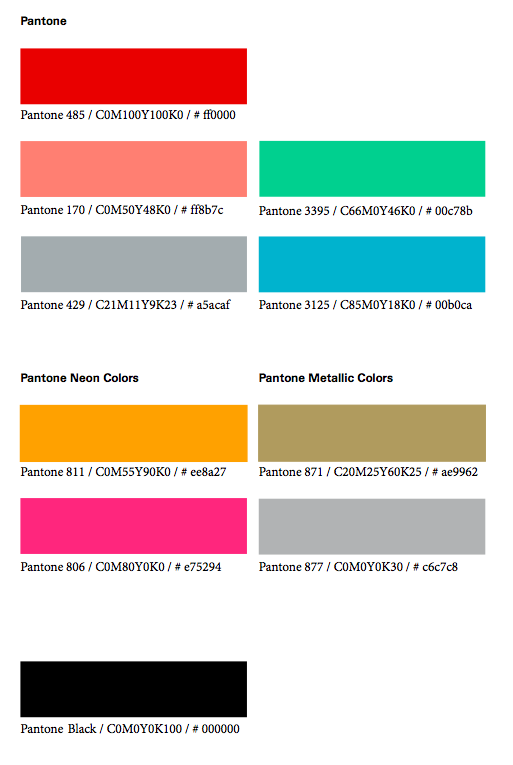
3. Network elements. These imply connectivity, intersection.
4. A 'composition zone' defined as a space to be filled with image and typography depending on the application.

5. Grid logic. Basic rules about how to handle negative space keep the logo system from feeling cramped to squashed.
6. Typography. Univers for headlines, Minion for pretty much everything else. No frills.
This set of guidelines provides the building blocks needed to construct a wide range of documents and other visualizations. By spending the time to think about the visual expression—the brand—of our work up front we were able to move quickly at later stages. New publications, new documents, new projects didn't bear the burden of starting from scratch, but they were also not overly-constrained. We had enough freedom to produce a variety of visual expressions that hung together as a family, while each having their own character.
We put this much effort into the visual language of our initiative because that was one low-hanging fruit of differentiation. As newcomers to the market of ideas in 2009-2010 we felt that we would have to stake a claim for ourselves, and while there are a wide variety of very smart people saying and writing very smart things in the communities of social innovation, sustainability, government reform, and the others that we've traveled in, the level of visual sophistication was somewhat lacking.
The ideas are what matter in the end, and I hope the value of our work is determined by the value of nothing other than our thinking and execution. The time we spent on the visual expression of HDL was our way of imbuing what we do with a great deal of care, and in doing so respecting the time and attention that you've given us.
With the trip behind us and the book to press, our focus is entirely on HDL 2013, which kicks off in T-Minus 12 days.
This means our life is a series of checklists, one of Marco's favorite activities.
- Catering? Got it, delicious.
- And they have enough tables? Yup.
- High powered projector? Check.
- Speakers briefed? Done.
- Wayfinding? Working on that one.
- etc…
We have been using Eventbrite to manage registrations for this event and I highly recommend the service if you have not used it before. It just works—and in the process of just working it casts off all sorts of useful data.

The blue spike you see at the beginning there is the first day that tickets were available and we mailed an announcement out to people who had signed up for the launch announcement.
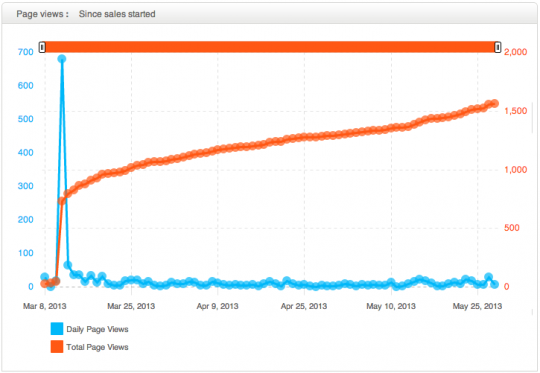
Our conversion rate is about 1/9, meaning that out of every 9 times the event page is viewed someone signs up for the event.
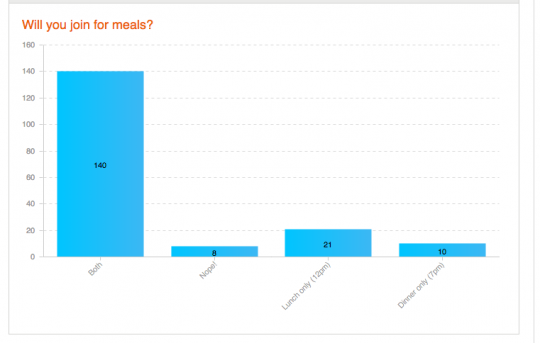
Makes the catered happy. Important.
Data has been on my mind a lot lately. As Justin and I traveled from place to place, the question that kept coming up was, "how do you measure your impact?" We can point to specific successes, such as the number of large-scale timber frame buildings (4) that have taken advantage of the changes to the fire codes that our Low2No project helped unlock. We could (but have not had the resources) to do a business case analysis of the new life that timber construction could breathe into the Finnish wood industry. We could (but have not had the resources) to assess the economic impact of a more fluid food entrepreneurship sector.
What is the economic value currently unrealized because of the quirks of the food service real estate market in Helsinki? These are questions that can be answered on a reasonable timeline with the right skill and time. But when we are talking about systemic changes (like adjusting the emphasis in school curriculums, or even deploying new models for schooling altogether) are we prepared to wait a generation or more for results that allow us to assess outcomes? And will the results come in a form we're prepared to recognize? And while measuring outcomes is one useful activity, it is not the same as learning from activity and refining future activity.
What strikes me is the cost of measuring social and ecological impacts compared to the cost of measuring economic outcomes. We've had more than 150 years of practice (or more) at measuring (and building tools to help us measure) financial results. We'll be lucky if a fluency in measuring other forms of value can be effectively booted up in half that time—not that we should be so patient.
Tech startups offer a useful, yet frustrating, analogy. By virtue of their venture funding, many startups temporarily exist outside the realm of direct market feedback. That is, their founders worry about having a business model and the possibility of making money in the future, but they do not have to worry about finances on a daily basis the way a butcher shop or a plumber might. Venture capital turns income into an externality—for a little while. Yet in the absence of direct feedback from the market, tech startups are still able to make educated decisions based on data: usage data.
By virtue of operating websites and apps via centralized servers, vast amounts of usage data come for free in the form of server logs. The cost of measuring performance is built into the cost of operating an online service.
For instance, I can tell you with a quick glance at the Google Analytics for this website that we've had 4615 visitors in the past 30 days and that 1.72% of them arrived while searching the internet for "Marco Steinberg". The sheer wealth of data available to me, as someone who runs a website, is overwhelming, and this is using free tools available to any site owner. Those who operate their own apps and have their own engineering teams have the ability to further build custom reporting and analytics tools that zoom in on the details they care about most.
Friend-of-HDL Cassie Robinson wrote recently about using data to steward systems. Data, she writes, helps us re-route our actions when needed. And I do agree, but much of what we do is still beyond the reach of useful data. The real challenge is the high cost of measuring non-financial value. How do we make accounting for social and ecological impact cheaper, faster, easier? How can we achieve the same efficiencies enjoyed by services that run on servers for those impacts that only happen in classrooms, on the street, or in a forest for instance? The internet of things is beginning to provide more diverse ways to measure environmental performance by dropping the cost of sensors and making them smaller than ever before. Can we also find ways to lower the cost of measuring human experience, behavior, perhaps even mood? Can we drop the cost and pain of measuring outcomes as a key part of supporting social innovation?
Proving your value is always the obligation of an upstart, but asking social startups to prove their value and invent a way to cost-effectively measure their value at the same time is a tall ask. If you know of anyone who's taking this on as a challenge please drop a note in the comments. We would like to hear more about it.
In other news, Brickstarter was in the Economist last week (week of May 18th issue) and that book is almost done. No, really.
The book we mentioned last time is now—literally right now—being printed. Copies available at HDL 2013.
With two and a half weeks of travel behind us, and just a few more days left on our HDL tour, the most common question Justin and I have been asked is, "are you ready to kill each other?" On the contrary, we're lucky to travel well together. This kind of trip would be impossible otherwise.
Today is London, fresh off the plane from Dubai. Later today we will give a talk to the MA Design Futures students at Goldsmiths University. I'm especially looking forward to this, as I hope we can spark a discussion about the boundaries of the applicability of design fiction. HDL has been an attempt to push beyond the fictive and that's one of the things we're most proud about.
Dubai was a quick stop, but we enjoyed a couple of morning sessions hosted by Noah Raford in the Prime Minister's Office. The conversation there was focused on improvement of services, the importance of synthesis (and thus design ability), and prototyping towards solutions. Many thanks to Noah for putting these discussions together. Although it's more recognized for deep spending on hard infrastructure, it was impressive to see the amount of attention being poured into the soft infrastructure in Dubai as well.
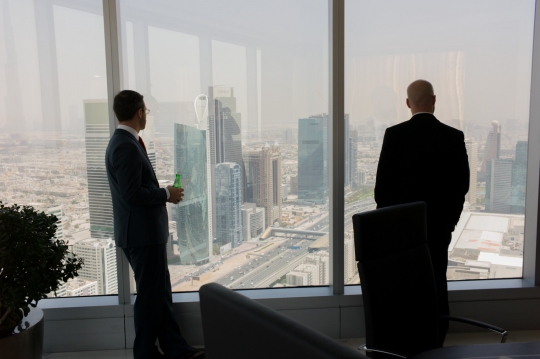
Noah and Justin survey Dubai from the PM's offices.
We also managed to zip down to Masdar City, which has long been part of our discussions around Low2No. We've seen Low2No as an alternative model to Masdar, one that's more appropriate for cities with legacies of built form, legislation, and financial regimes that cannot be swept aside. Seeing Masdar in person was enlightening. It's hard for such a hugely ambitious project to ever meet the hype, and there's certainly plenty of room for Masdar to grow into the reputation that it has created for itself. Still, what is happening there now may end up being more interesting than the original Foster master plan. As the planning adjusts to a smaller scope and a smaller budget, perhaps something more modest and more replicable will emerge?
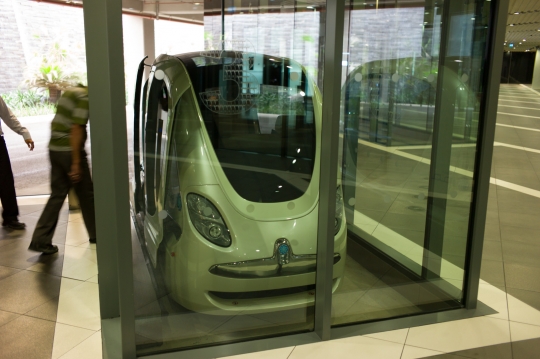
Driverless Personal Rapid Transport unit at Masdar City.
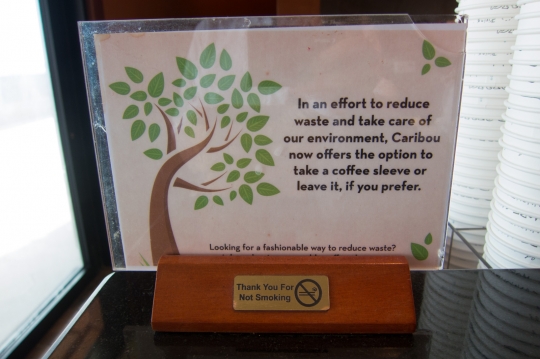
It makes sense to start with small steps, but maybe this is a bit too small?
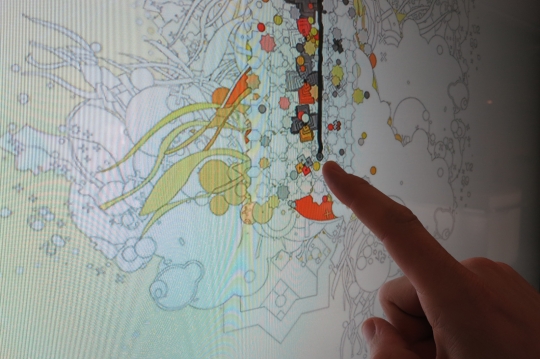
Generative art 'guestbook' at Masdar.
We arrived to Dubai via Hong Kong, where Justin and I stopped over to meet with Cees de Bont and Alvin Yip of Hong Kong Polytechnic University School of Design. They shared insights about the current state of design in China that have evolved since our last visit there in 2009, including a growing recognition of the role for designers in social innovation. In fact the Jockey Club, which makes a substantial purse off of track betting, has endowed the Design Institute for Social Innovation. They are just booting up now, but we will pay close attention. It was encouraging to hear about these plans, as it makes the HDL closure easier. HDL is fading out, but the ideas and the practices of strategic design certainly are not.
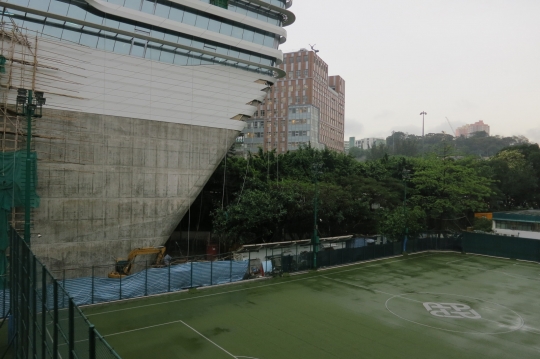
HKPU's new School of Design building is almost ready. And it's massive!
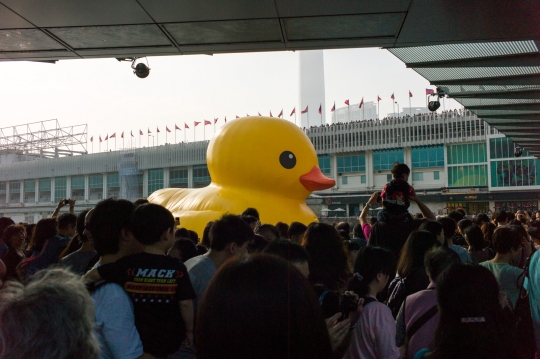
Hong Kong is currently in love with a giant rubber ducky.
Before Hong Kong it was Tokyo. Justin describes it thusly:
After an overnight from Sydney, we landed on beautiful spring morning in Tokyo. The privilege of arriving at Haneda Airport, close to the center, is that some of the scale, complexity and diverse functions of Tokyo are revealed. From the air, Japan’s industrial base, which is mostly absent in Hong Kong, seems robust, busily making small things very well.
We were invited by the University of Tokyo i.School to give a talk to students, staff and like-minded practitioners on strategic design and our projects at Tokyo Midtown Design Hub. Our gracious hosts Fumiko Ichikawa and Hiroshi Tamura had teed up an engaging facilitated workshop following the talk where the audience was asked to define “what is strategic design” (which we probably didn’t help them with during our talk!) and how could the approach be used to aid in tsunami recovery. With this group the idea of building a rigorous and active feedback loop between understanding the nature of the challenge systemically, and acting to make change via proposals and projects, clearly resonated.
Groups sharing their ideas about strategic design after our talk. Photo: Hiroshi TamuraSimilarly, during a workshop we ran at the i.school on the following day with Tokyo’s leading social innovators, the need to better connect thinking and doing was a popular topic. I was struck by how the tsunami had cracked open the opportunity for individuals to rethink and possibly begin to take on Japan’s structural challenges such as the widespread expectation lifelong employment with a single large employer or the lack of funding for smaller enterprises. The social entrepreneurs in the room seemed well equipped to compel Japan to remake itself as a more resilient society after the crisis.
On our last day in Tokyo, we had the pleasure of visiting ETIC, which has been working for two decades to ignite entrepreneurship among Japan’s youth. Their experience during that time suggests that Japan’s entrepreneurs are heading in the right direction as they are now more professional and impact oriented than ever.
We also visited the Nippon Foundation, which like Sitra, has a broad mandate to spur innovation nationally. Impact, measurement, outcomes, etc. are all ideas that are in the water in their organization as well.
Tokyo was a wonderful stop on our tour. On the one hand, their highly sophisticated culture has produced incredible gains for society, but on the other the dominate cultures of decision making seem opaque and unbendable to many. But events like the tsunami are providing a way in for social innovators like the ones we met at the i.school.
Before that? Australia.
While Justin and I have been traveling, Marco was also on the road with a stop in Amsterdam at a Labs summit and a stop in London at the Institute for Government. Written up here and tweeted here.

Best part of a long flight is that you can write emails without receiving any. It's pure inbox upside.
Amidst all of this, Legible Practises is going to press. No pictures yet of the printing process, but here's a glimpse of what it will look like:
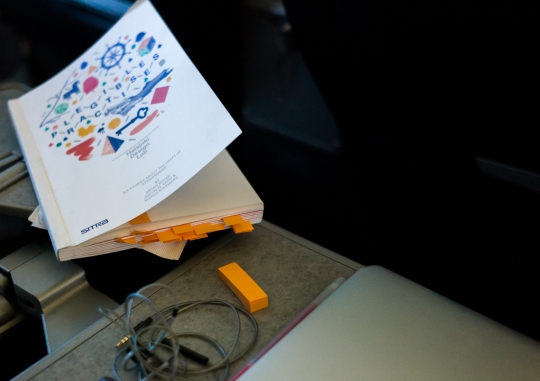
Editing the final draft of the book.
Toronto, Melbourne, Sydney. That was week 217. In other words, a blur.
Some images:
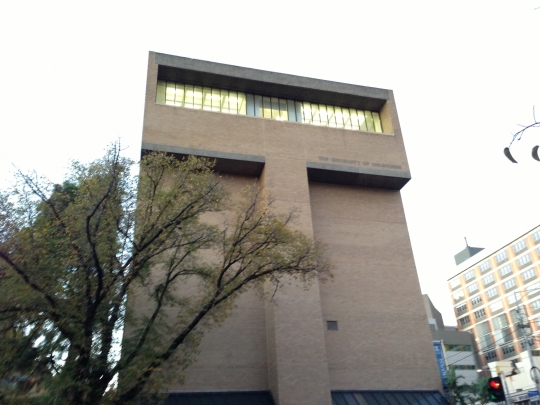
Friend-of-HDL Rory Hyde organized a talk at the University of Melbourne Faculty of Architecture that ended with a great discussion about the future of architectural education + strategic design.

The Difference, a unit of PWC, hosted us for a morning discussion in Sydney. Thanks to Martin Stewart-Weeks of Cisco for the introduction.

Government offices in Sydney, where we gave a lunchtime talk with a group of senior civil servants, have an a very modern building with a thoroughly antiquarian electronic clock. Nice touch.
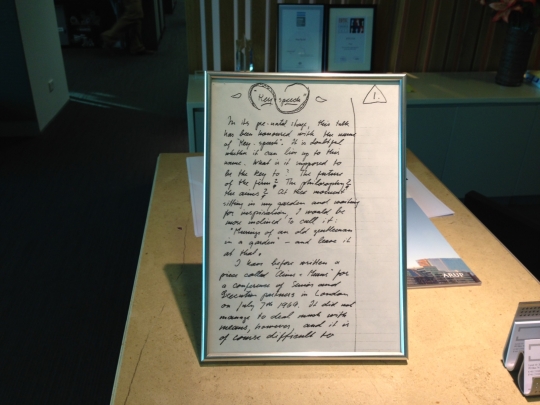
And we ended a busy day in Sydney with a stop at Arup, who keeps a copy of the Key Speech by the front desk.
Next stop: Tokyo.
The last two weeks have been consumed by the task of finalizing our latest and last HDL publication. It's a book called Legible Practises that contains six stories about the craft of stewardship. Huh? Stewardship, as we define it, is the art of getting things done when many minds are involved in the conceptualization and many hands in the implementation. The six stories we look at are each examples of changing the tires of a car while driving. In other words, changing systems while they're still humming (or clunking and sputtering) along. More on this shortly, when it's actually out the door. Right now a more pressing concern weighs on our minds as Justin and I camp out at a cafe in Toronto: the weather.
Toronto is warmer than expected. Naturally, the day we spend enjoying the city and meeting with groups like The Moment, MaRS Solutions Lab, Ontario College of Art and Design Strategic Innovation Lab, and MASS LBP is the day that's rainy and gray. Today we are frantically finishing work before hopping on the next flight and it's gorgeous. Nevertheless, this has been another inspiring visit to Toronto thanks to the forethought and preparation of Social Innovation Generation. Thanks to Tim and Satsuko!
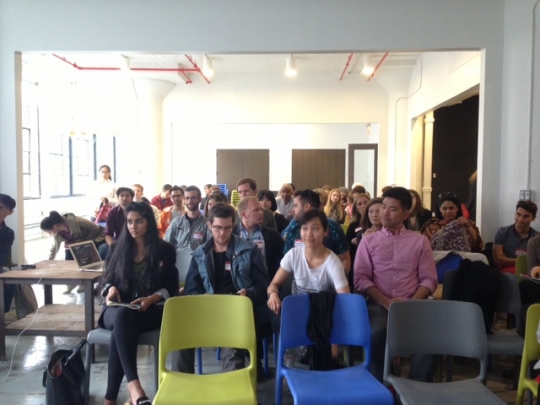
Hello, Centre for Social Innovation!

A morning discussion about strategic design, ethnography, politics, and more hosted by SIG and The Moment
This is the second stop on our HDL Moi Moi tour. As part of closing down the initiative, we're visiting people in New York, Toronto, Melbourne, Sydney, Tokyo, Hong Kong, Dubai, London, and Dublin to share what we've learned. On Sunday Justin and I met in NYC to give a talk at the Centre for Social Innovation, a newly opened coworking facility catering to social enterprises and others with similar interests. It was an honor to be part of the first event that they've ever hosted in the lovely new space.
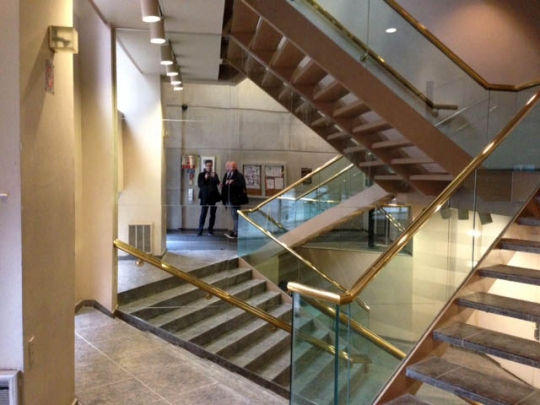
Welcome to the matrix... of stairs.
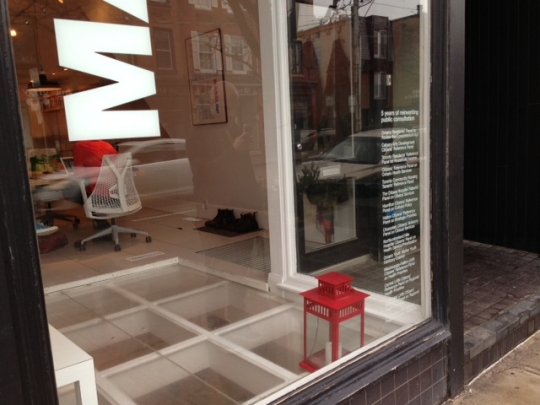
MASS LBP's offices have a CV of sorts on the window. Nice.
In a couple hours Justin and I will load ourselves onto a plane bound for Melbourne. There we have a public talk lined up at the University of Melbourne Faculty of Architecture (see you there?) as well as other meetings around town.
As we move from venue to venue I feel guilty because we keep mentioning the publication that we are about to complete. In fact, if I don't commit all of the final edits before we're airborne, it's going to be too late. So the pressure's on. Justin's working on edits now—very seriously, as you can see.
T-minus 40 days.
This week we hit an important milestone in text. Monday was a long day but we managed to deliver a 100% manuscript for the next (and final) HDL book. We're still figuring out exactly what to call it, but this one is about how people use projects to develop new solutions and new cultures of decision-making simultaneously.
After handing the draft off to the graphic designers I felt an almost immediate sense that we had left out a few things. We'll revisit that after the weekend. In the meantime, things like this are flowing into my inbox:
That's a draft of the layouts (zoomed way, way, way in). I've come to appreciate the shapes of the letters in the typeface Minion, which we always use. Quite a handsome gee, no?
As for unexpected details, here's another one that comes courtesy of the new Finnish passport design:
A pair of upcoming events deserve a mention here. First, Marco will be at the Institute for Government in London on May 10 to discuss design-led policy. More details here. Justin and I will do a similar session co-hosted by the Centre for Social Innovation in New York and the Parsons DESIS Lab. That's April 28th and you can register here.
Hope to see you at one of those events.
Last week Justin and Marco were in Boston to assist MIT's Collaborative Initiatives with a pair of studios. Things up there went well and it ended before the city suffered an attack and subsequent chaos. Luckily everyone is safe and accounted for, but our thoughts are with those who were less fortunate.
Video crews everywhere. That's the first impression of my time in Bangkok, where Marco and I spent a week observing and coaching Future Innovative Thailand (FIT) as they kicked off their initiative by running three parallel studios. Comes with the territory when some of the country's most recognized political leaders are sitting in on the studios. No pressure.
Our host, Nuttaphong, adapted the studio model to his own context and purposes and we got to see it all play out. Given the language, it was not always easy to follow along but we still gleaned a lot from being there. Thanks to our hosts for their hospitality, enthusiasm, and engagement during an impressive (and exhausting!) week. Congratulations to Nuttaphong and the team on the launch of their initiative.
Perhaps the biggest difference between these studios and the ones that we have done in the past was the presence of 'owners'—mayors, MPs, and other decision makers—in the room for the length of the week, as opposed to just at the end for the review. We never attempted to staff the studio in that way because, frankly, we didn't think it was possible to get a politician to clear that much time in their perpetually full schedule. Thailand, on the other hand, proved that it can be done!
For me one of the most useful realizations was also something that I probably should have recognized before. When we wrote In Studio we left a coy blank spot in the middle. Perhaps because it's labeled a 'model' people often assume that it's a model of facilitation. Rather, the studio model is about everything but the tactics of group facilitation. In that sense it's dogma-free on purpose. If U Theory is your thing, OK. If you prefer another means of facilitation, fine. You can use whatever process you are comfortable with so long as you move from learning and insights, to architecture of problem, to architecture of solutions, and you end with a review.
Yes, Bangkok was good in that it showed us how the studio plays out when the makeup is a bit different. When the parts are reconfigured. As for content, the focus on good governance (including anti-corruption) was an issue that was constantly in the air. As a topic that did not come up very often in Finland, I enjoyed talking through these issues with the studio teams. Scale was on the top of everyone's mind too, as it should be. How can we scale up good ideas quickly? Finally, it also showed us a few areas where we should revise the How-Tos in the book. If we manage to get a Print on Demand version done before June, that is!
Books, books, books. I spend most of my time writing these days, with Marco and Justin doing the same. We are about two weeks out from the 100% draft deadline for a title we're tentatively calling Stewardship: Leading into Practice. This will be the final HDL publication.
Between bouts of writing Marco has been on the horn with groups in the UK, US, and Switzerland as well as tending to meetings in Helsinki. I enjoyed a morning meetup with Eli Malinsky to learn more about the Centre for Social Innovation's expansion to NYC and also spent an afternoon with Eduardo Staszowski's students at the Parsons/New School School of Design Strategies. These were violations of a (not so) strict moratorium on all appointments until after the book is drafted, but they were worthy transgressions.
The Brickstarter book, by the way, is still forthcoming. It is coming along and we're hoping to have it completed before the end of the month but no promises yet.
The Design Exchange blog is still hopping with activity from Hella and Sirpa.
So then, back to the writing. And to the event prep. And the trip prep. And the coffee, actually.
T-Minus 66 days.
Good morning from Bangkok. Marco and I are here for the week as the Future Innovative Thailand Institute launches their Blueprint programme, which is an initiative to redesign policy around education, social economy, and governance. They've been using our studio model as the basis for the work. But more about that next week.
Last week we were able to post the finalized details for HDL 2013. You'll find more here, as well as registration which is open to everyone. The summary is that we will have an event in three phases: conference, conference with drinks, drinks. We want it to be a chance for the community of strategic designers to gather and if that sounds good to you, we hope you'll join. Here's who will speak:
- Timo Arnall on seeing the invisible
- Christian Bason on design as management and leadership
- Gill Ereaut on linguistics and change
- Alejandro Gutierrez on designing with communities
- Lärke Johns on innovative bureaucrats
- Chelsea Mauldin on design and government
- Carl Mossfeldt on changing systems
- TwoPoints on the design of HDL's visual identity
- Anna Valtonen on educating designers
Meanwhile, book logistics have been ruling my life. Last week included writing odd little things like the paragraph below and occasionally drawing very bad pictures to go along with it:
We see a woman standing, she is tapping a seated gentleman on the shoulder (he is wearing a coat) while holding a microphone behind her back. She’s about to ask him to stand up and make a pitch but he doesn’t know it yet. Perhaps we see some abstract indication of the other people at the table, or at nearby tables.
That's part of the briefing prepared for our illustrator who is going to be making drawings of different 'points of practice'. Since a lot of the book is describing abstract notions, we are taking some care to bring a visual dimension to the storytelling that errs on the side of being overly concrete. Before jumping into this I didn't have much of an idea how to brief an illustrator but it seems to be working.
What else? Marco was staying put in Helsinki, working on Design Exchange. He'll have Sara and some people from the City of Lahti over for a show-and-tell at Sitra soon.
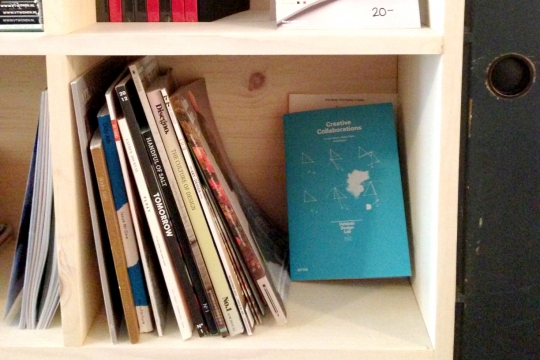
On my way to Bangkok I made a quick stop in San Francisco, where I spotted our Creative Collaborations book on the shelves at Makeshift Society. Great!
T-Minus 84.
In conversation these days I catch myself talking about "another six months" of Helsinki Design Lab, but we've only four months left. Maybe we should change the weeknote titling from incremental updates to a T-Minus format. T-minus 94 days.
The HDL 2013 event is heavy on our minds these days. It will occur in three seamless parts: conference, conference with drinks, drinks. We'll be at Kellohalli, the same space that hosted Open Kitchen, so it will be a pleasure to be back with our friends Antto, Elina, Jonna, and the rest of the crew. The outdoor spaces at Kellohalli will be in full bloom by June, and with 19 hours of daylight you will have plenty of time to enjoy them. We are planning to start the event around 11am and go into the evening to 11pm or later if people are up for it. June 10th is a monday, but why let that stop you?
Sign up here for further information and we hope to have the actual registration and final details available next week.
My focus is almost entirely on the as-yet unnamed book, which provides a never-ending supply of lists to make, emails to write, things to confirm, and schedules to align. Observant readers will notice one thing missing from that list… writing. That's happening too, but not as smoothly as I would like.
Recently I had the pleasure of meeting Fumiko Ichikawa, whose business trip to NYC provided a serendipitous opportunity for us to plan an HDL workshop in Tokyo with the i-School and potentially some other partners this May.
As we prepare to close HDL it's encouraging to see the studio model being adopted and adapted by others. This week I was in Toronto for a meeting at Evergreen (a remarkable organization, by the way) and caught up with people from SIG and MaRS who are in the midst of setting up their own lab, inspired in part by HDL. Next week Marco and I head to Thailand to assist the Thai Health Promotion Foundation as they launch an education programme also inspired by our studio model. This is why we spend time writing blog posts and making our practice legible. It's heartening to see the ideas and approach spread.

This excellent map at the Evergreen Brickworks shows Toronto's network of ravines rather than its congested streets.
T-minus 94 days.
There's one thing we're not doing enough of right now and that's writing. Between Marco, Justin, and myself we have about four pieces of writing due to various groups and I think we've found just about every possible means of doing anything but writing.
Less about what needs writing and more about what has been written. Our In Studio book is now (finally!) available for sale online thanks to the MIT Press bookstore.
Marco has been in Brussels for the Commission and Sweden for the Swedish Industrial Design Association. Justin is a new father (congratulations!) so he has mostly been on parental leave, but here and there I sneak him an email as we nail down our travels for April and May. We've also had help from Fumiko Ichikawa, with whom we are putting together a workshop in Tokyo and Tim Horton, who we hope to see again in Australia. Other stops are likely to be Toronto, London, Dublin, and Dubai. But not in that order, hopefully.
And in between, lots of time on the horn to line things up for our final HDL event. We're getting close to having a complete roster for the HDL 2013 closing event on June 10th in Helsinki (sign up here to be notified when we have full details). This event will be a gradient: we'll start around 11am with talks, move to talks with drinks in the late afternoon, and end the night by 11pm in celebration mode. The talks we're lining up are a mix of people doing things similar to HDL and people whose work has inspired us. Marco, Justin, and I will probably also give a talk or two about our work, and about strategic design in general.
More than anything, we want this event to be a good excuse for strategic designers to get together because there still isn't really an event or publication that anchors this community. When we relaunched HDL four (coming on five!) years ago we wanted it to be a platform to bring together disparate but similar threads spanning multiple disciplines and geographies. Hopefully HDL 2013 does the same.
We've been taking care of infrastructure lately. Still some work to be done there, but not a ton. This means: being on the horn to convince people to help us with publications and other wrap-up related efforts; writing contracts to hire them; organizing bits of the office; catching up on email so that we're free from that nagging feeling of being behind.
The Design Exchange Programme is hitting its stride. Sara is finishing up her year-long placement in the city of Lahti where she was helping them redesign their approach to public engagement. As Sara is also having a baby (congratulations!) she will not be continuing and we're sad to see her go. Nevertheless, her story has been blogged here (mostly in Finnish) and will remain for reference. Thanks for being our first very courageous embedded designer, Sara!
Sirpa at the Ministry of Employment and Economy and Hella at the Ministry of the Environment have also been blogging actively, including short summaries in English.
We ended last week by hosting a breakfast with members of the city, Tekes, and other organizations around town to talk about the possibility of taking Open Kitchen forwards. If this works, we'll have been able to play exactly the role that Sitra is best at: develop a new concept, test it out, and pass onwards bettered by iterated findings.
I've enjoyed following along the developments of some of our participants as they take steps now towards opening their own ventures. You can follow Jerome as he mounts a sourdough bread revolution in Helsinki. If you're lucky, you'll get a chance to try his products; the bread wowed us all during Open Kitchen.
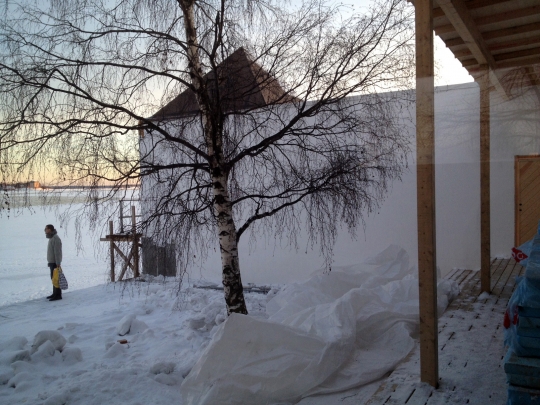
Snapshot from a visit to the Kulttuurisauna which is nearing completion.
Rory is waiting on me for final updates to the Brickstarter manuscript as I coordinate with Kali and Dan to get things just right. Meanwhile Rory is working with Bitcaves to take the manuscript forward into a book. This also serves as a reminder that I will soon need to think about revamping the Brickstarter website as we transition the active prototyping there to a project called AvoinKotka (Open Kotka).
We were very happy to see Brickstarter included in a recent issue of the magazine form, The Making of Design, with an essay by Justin McGuirk. There's also now an online video of a talk I gave at the World Design Forum in Eindhoven last autumn which discusses Brickstarter and our other projects:
Not so sure about the graphics of this video. Those are not my slides!
This week Marco is back in the office after a busy trip to the US. He and Justin were visiting the Cleveland Clinic to see an implementation the work we put together during Stroke Pathways, a research project at Harvard that served as a proving ground for our current strategic design approach. Sounds like it was an enlightening trip but I haven't had a chance to catch up with either of them for more than a minute. That's because as Marco returns I'm packing up. Tomorrow I move to New York and will be based there from February onwards as we wrap up HDL. A big change, for sure, but since we've been traveling more or less constantly for the past four years it's not going to affect our collaboration much. Though it does mean I will be waking up for some very early phone calls.

Justin and Marco visit the salad garden at Clover food lab.
While in the States Marco also had some meetings at MIT and then gave a talk at HarvardxDesign conference, which Justin and I have been advising and helping to get off the ground. Great stuff there and I swear the color similarities are just a coincidence!
We're still working through the responses to our HDL road show announcement, which means there's time for you to throw your name in the hat if you would like us to come give a talk.
Undoubtedly, readers of this blog have already read Marco's post from last week, but in case you missed it, we've recently made an announcement about the future of HDL. Hearing from the community around HDL in the wake of the announcement has been encouraging. Thanks to all of your for your continued interest in our work. I hope we are able to sustain it for the next five and a half months because we have no intention of slowing down.
On the contrary, there's still lots to do. With the ending point for HDL clearly marked on the horizon, we're entering a kind of Benjamin Button mode. We'll be getting back into the habit of writing how-tos, working from practical issues ("how to budget a project", "how to brief a photographer") through to some of the more fundamental aspects ("what abilities are needed in a design lab", "how do you pick projects"). We'll be talking through and explaining how we set up HDL so that the site becomes as useful an archive as possible for others, elsewhere looking to do something similar.
Marco and I have been spending time at the whiteboard tracing out a loose plan for the HDL closing event on June 10th. It's going to be free and open to all, so I hope you'll sign up and consider joining us. We're also keen to hear your feedback and questions about HDL and the work we've been doing. This will inform our efforts to ramp things down.
Back on the whiteboard, we've also been revisiting our proposed table of contents for the forthcoming book on stewardship as well as generally trying to get a handle on all the things we want to do before sweeping the floor and turning out the lights. Tomorrow we'll have a conference call with Justin and loop him in. This is one of the ways we usually work: a couple people bat ideas around until there's something there, then we make a little presentation to the others and start over.
Open Kitchen got a nice write-up in Kauppalehti recently. We're happy to see the Facebook group for the participants still active and are hoping to join them for a small reunion next week. Right now Mariaana, a journalist we asked to sit in on the programme, is writing up notes from each of the courses and we will be publishing those online as soon as we can. Next week we're also hosting a small gathering with some local stakeholders to see if we can find a more permanent host for the programme.
This blog post is the second of the night, behind what I just put up on the Brickstarter site. Over there we announced that Sitra will be publishing a Brickstarter book in 2013 (yup, more writing) as well as beginning a very small experimental effort with the city of Kotka in eastern Finland.
My main focus at the moment (and through much of the holiday) is getting the manuscript into shape. We're using the blog as a starting point for that, but revising and updating things with new content as well as making sure they work equally well on the page. I particularly enjoyed writing the introduction, which includes the epic battle between wind turbines and glider squirrels. You'll have to read the book to find out who wins.
We've also been working on a quick project with Two Points, the graphic designers who created the HDL visual identity. I'll leave the content of the project a surprise for now, but here's a small clip from one of the files they sent. It's part of a poster.

Next week Marco takes off on a trip to the US where he will be participating in the By Design event at Harvard. He'll also meet with some people at MIT and make a visit to the Cleveland Clinic, which is now testing some of the ideas developed during Stroke Pathways, a project that Marco led at Harvard (and Justin and I contributed to) which laid the groundwork for our strategic design approach here at Sitra and HDL. We're anxious to hear how it's going there.
On the theme of travels, we're going to make an effort to be out and about even more than usual in the coming months. If you're interested in having an HDL or strategic design perspective at an event near you, drop us a line. No promises, but we'll try our best to be accommodating.
Onwards!




